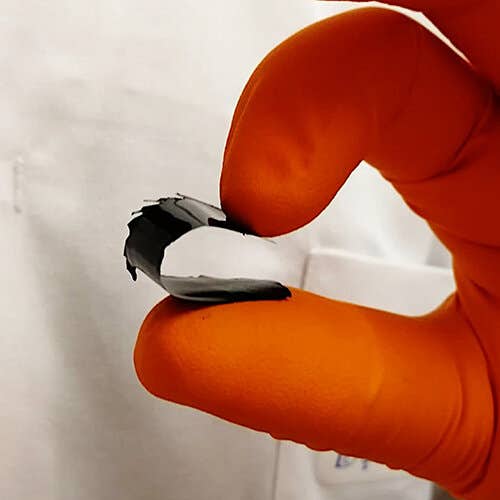Innovative ink coating can power wearable devices via heat
Researchers at KTH report that they are closing in on a way to replace batteries for wearables and low-power applications in the IoT.

[June 17, 2022: David Callahan, KTH Royal Institute of Technology]
A piece of film is coated in thermoelectric ink. (CREDIT: KTH Royal Institute of Technology)
Researchers at KTH report that they are closing in on a way to replace batteries for wearables and low-power applications in the internet of things (IoT). The answer lies in an ink coating that enables low-grade heat, which is generated by devices, to be converted to electrical power.
Publishing in American Chemical Society Applied Materials & Interfaces, the researchers from KTH Royal Institute of Technology in Stockholm report that they have developed a promising blend of thermoelectric coating for devices that generate heat amounting to less than 100oC.
Thermoelectricity is the direct conversion of heat to electricity. It’s possible to capture the heat that a device generates and convert to power that can be used by the same device, or another device. What are required are specially-designed thermoelectric materials.
When one end of a thermoelectric material is heated up, charge carriers (electrons and holes) move away from the hot end towards the cold end, resulting in an electric current. One challenge is in managing the thermal conductivity and resistance with materials that can be applied to a large area without losing their performance over time.
Muhammet Toprak, Professor of Materials Chemistry at KTH, says that the research his team performed focused on the design and development of hybrid thermoelectric materials for room-temperature operations, which integrates solid state semiconductors with flexible materials such as polymers, to formulate inks.
Related Stories
Toprak says that the coating can be applied to any surface that dissipates heat, to generate electrical power. The research also makes headway in gaining better understanding of the capabilities and limitations of materials used for hybrid thermoelectric material design.
“These results open a new low-cost and sustainable way of producing and implementing thermoelectric coatings on a large scale,” Toprak says. “In the short term, this is expected to make an impact for IoT and other low power applications. It could replace batteries by being integrated as a coating in the form of wearable electronics.
“In the long run, with the use of more sustainable inorganic thermoelectric materials compositions and sustainable biopolymers, such as cellulose and lignocellulose (or plant matter), the use of this technology on large areas will impact the adaptation of thermoelectric technology for efficient heat-to-power energy harvesting, as a complementary means to green transition.”
The work was performed in collaboration with University of Valencia, Spain, and University of Warwick, UK.
Note: Materials provided above by KTH Royal Institute of Technology. Content may be edited for style and length.
Like these kind of feel good stories? Get the Brighter Side of News' newsletter.
Tags: #New_Innovations, #Medical_News, #Wearables, #Heat, #Research, #Science, #Power, #Technology, #Global_Good_News, #The_Brighter_Side_of_News
Joseph Shavit
Head Science News Writer | Communicating Innovation & Discovery
Based in Los Angeles, Joseph Shavit is an accomplished science journalist, head science news writer and co-founder at The Brighter Side of News, where he translates cutting-edge discoveries into compelling stories for a broad audience. With a strong background spanning science, business, product management, media leadership, and entrepreneurship, Joseph brings a unique perspective to science communication. His expertise allows him to uncover the intersection of technological advancements and market potential, shedding light on how groundbreaking research evolves into transformative products and industries.



